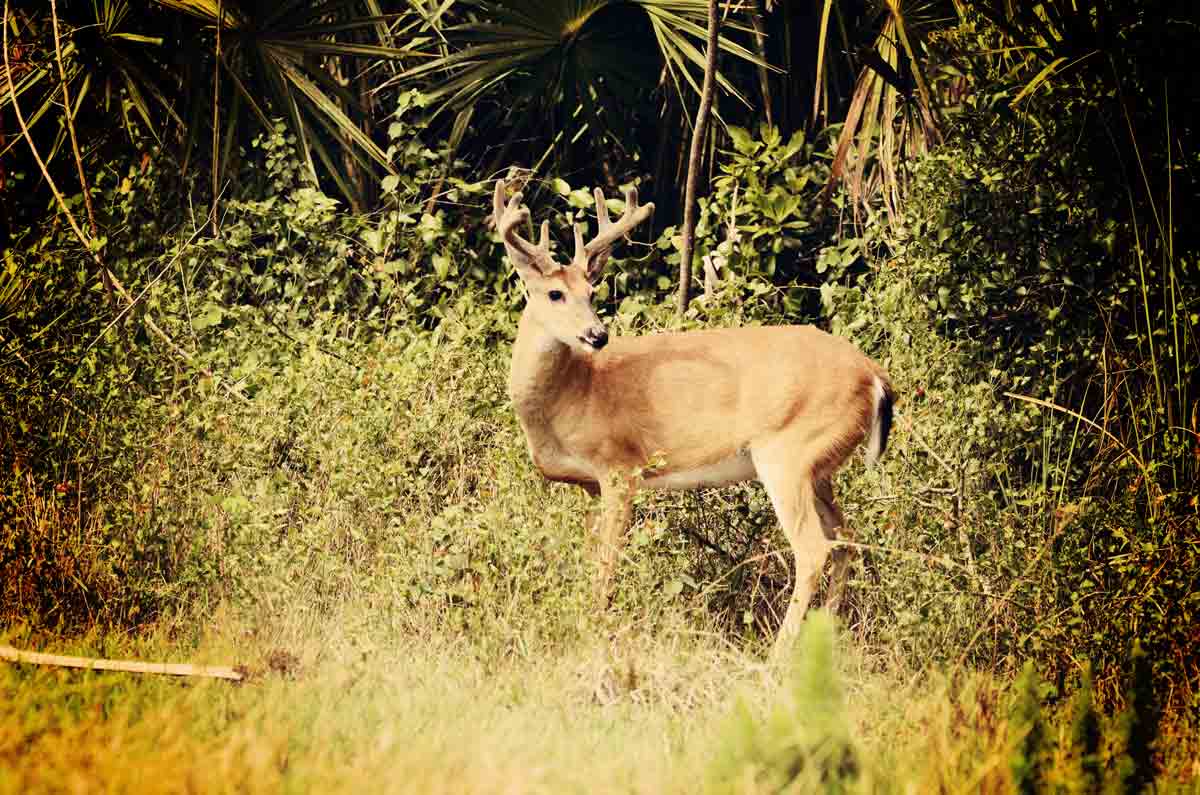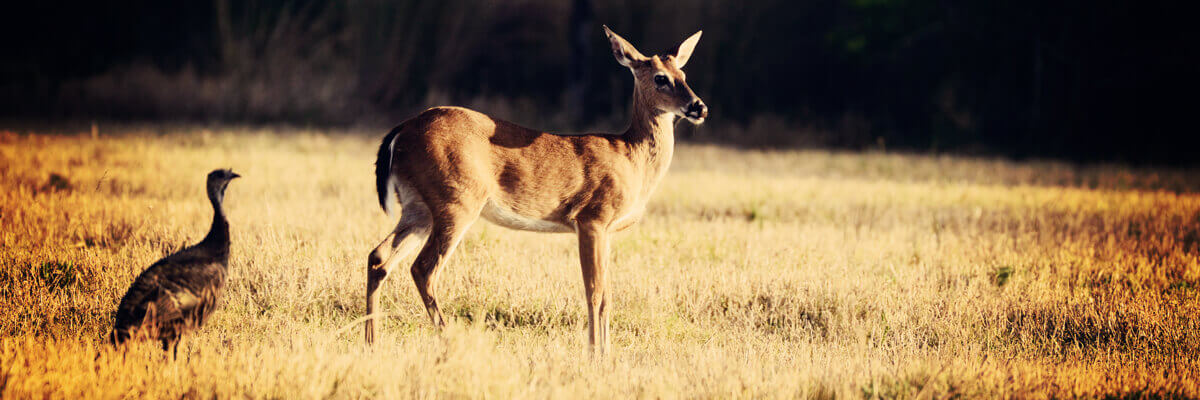by Scott Sommerlatte
(Originally published in Strung Magazine #4 – The Upland Issue)
I can still vividly remember where and when I first witnessed the early rut. For the longest time, I did not believe it.
I was poling a client through the marsh of a barrier island on the Gulf Coast when we saw a little six-point whitetail buck chasing a doe. He was displaying all the signs of a rutting buck. After watching for a while, we noticed this buck periodically looking over his shoulder, while trying to get the occasional sniff. Suddenly we heard a commotion that beat all—a much larger buck was plowing through the shallows of the remote tidal flat. He was clearly intending to steal the younger buck’s date. When they locked antlers, it was a sight to behold. Water flew in all directions, and it was over almost as soon as it began, with the older buck pridefully standing guard over his prize.
The account above does not paint the full picture, as this occurrence is witnessed time and time again all over North America. It is what all deer hunters dream about: the rut! What makes this story special is that it happened in mid-September on the middle Texas coast.
I still did not believe what I saw, and wrote it off as being just some weird thing that I had seen because I was in the right place at the right time. That was until I was doing a photo shoot on a high-fence ranch in the Coastal Bend of Texas the following year and witnessed, yet again, a buck displaying surefire signs of rutting activity in mid- to late September—although this time I caught them in the act of consummating the relationship.
It was not until a few years later—when I once again saw rutting activity in late September on a new hunting lease a few miles inland from the Gulf of Mexico—that I decided to try some rattling on Opening Day of bow season (September 31 that year).
After only a few minutes glassing in the stand, I made out a good-sized buck making a rub on some low-hanging oak branches quite a distance away. I decided to try rattling because I had the wind in my favor to carry the sound. After situating my bow and nocking an arrow, I began to crack the antlers together. Within seconds, the magnificent buck made a beeline for my location. There was quite a bit of open country for him to cover, and he would stop occasionally to look around for any opponents. A couple more bangs of the horns would get him moving again, and in the process the racket attracted another mature buck to within 5 yards of my tree stand.
 That was an easy shot even with my longbow, but I wanted the nice 12-point heading my way. So I carefully and softly rattled the old sheds and brought the big buck to within 20 yards. He would not come closer. Yep, I passed up a nice, mature 9-point hoping to get the king of the woods, and came up short. I have a rule when hunting with traditional gear: no shots over 12 yards. It would have been my greatest success as a hunter.
That was an easy shot even with my longbow, but I wanted the nice 12-point heading my way. So I carefully and softly rattled the old sheds and brought the big buck to within 20 yards. He would not come closer. Yep, I passed up a nice, mature 9-point hoping to get the king of the woods, and came up short. I have a rule when hunting with traditional gear: no shots over 12 yards. It would have been my greatest success as a hunter.
Regardless, it was one of my greatest ever experiences in the woods, and I was now convinced that the deer on the Texas coast were rutting in September. I started researching the phenomena in books, on the Internet, and by asking questions of those who knew more than I did.
After about a year of reading, study, and contemplation, I came up with a hypothesis about why the rut happens so much earlier along the Third Coast. But before I get into, let’s look at a few facts regarding to Gulf Coast deer and the rut in general.
First, all white-tailed deer in North America are in the genus Odocoileus and the species virginianus. However, numerous subspecies live all over the continent. For our purposes, only three of these subspecies are relevant.
In regard to my early-rut tales above, let’s start with the subspecies known as the Avery Island deer, or Odocoileus virginianus mcilhennyi, distributed from the Coastal Bend of Texas across southern Louisiana. This subspecies was discovered in 1925 by scientists from the Colorado Museum of Natural history after they examined the remains of five deer from Avery Island, Louisiana, where Tabasco Sauce is made. The subspecies name was given to honor of Edward Avery McIlhenny, who allowed access to the samples. He also expanded the McIlhenny Company and its sales of Tabasco Sauce.
Little was known about Avery Island whitetails at the time, beyond their differential in size and detail compared to other whitetails. Since then, this subspecies has been studied and confirmed by biologists and by early-season bowhunters. Not surprisingly, these hunters may or may not witness the peak of the rut, which is usually around September 20. The same can be said about the two other subspecies covered here, because the best rutting activity rarely happens during an open hunting season.
Our next whitetail subspecies inhabit the low-lying woodlands and marshes of Mississippi, Alabama, the Florida Panhandle, and down into west-central Florida. This particular subspecies is known as Odocoileus virginianus osceola, or Florida coastal whitetail (FCW). They are subtropical to tropical, and show signs of breeding behavior that is more common in tropical deer species. There are rumors of FCWs rutting in February and into early March.
Odocoileus virginianus seminolus, or the plain ol’ Florida whitetail, is a subspecies that inhabits the cypress swamps, cabbage palm hammocks, citrus groves, and mangrove islands of South Florida. I cannot find a reference about the peak of the rut for this subspecies. However, based on information from numerous citrus grove and ranch owners in the region, these deer are almost always the earliest of breeders, with the peak of the rut usually happening from mid-August to early September.
Many Florida landowners who are also hunters have witnessed rutting activity as early as July. However, if you take into account that the Florida whitetail reportedly ruts in February and March, I ask you to define early or late. Are we talking calendar year, or do we base it on hunting seasons? I personally believe that hunting season each year begins on September 1. For all game, the calendar starts then, so the breeding that happens among the heard of Florida whitetails in February and March is technically late.
Now, regarding the subspecies names of Florida coastal whitetails and the Florida whitetails: After spending four to five months a year in southwest Florida guiding fishermen, I feel clear about where the names came from. Florida is rich in Native American lore, and government tries to honor that heritage by naming places and things with cultural significance in regard to the tribes who once inhabited Florida. These two subspecies honor not only the Seminole tribe, but also the great Chief Osceola.
Here are my observations and hypotheses based on my experiences in the woods of the Gulf Coast. As I studied and observed, I concluded that the Avery Island whitetails’ rutting activity was based on one single thing—survival of the fittest. Call it natural selection, evolution, or creationism, it’s all the same to me. The Lord made it that all creatures could evolve into what they needed to be to survive.
The Gulf Coast is plagued with two horrible things that neither we humans nor the wildlife, can avoid—hurricanes and mosquitoes. If you’ve ever seen a Gulf Coast herd of cattle anemic from loss of blood or suffocated by the mosquitoes they breathe in, you might understand that the deer that inhabit the same country might suffer the same troubles. And of course, there are hurricanes. Unlike the cattle, which have ranchers to take them to high ground, whitetail deer do not. I have witnessed numerous tropical storms and hurricanes along the Texas coast, and I can assure you that many coastal deer perish.
Now to the point. As a rule throughout North America, The rut is based mostly on latitude and the amount of sunlight that a deer sees daily. In short, the lack of sunlight that reaches the deer’s pineal gland causes a release of melatonin, which activates seasonal physiological changes, such as a release of estrogen in does and testosterone in bucks. This is what, to some degree, kicks off the rut.
As for when the rut starts, traditionally the farther north, the earlier the rut, meaning that the farther south you go, the later the rut. But why do whitetails along the coast rut sooner than those in the Texas Panhandle? Could Mother Nature have a hand in it? I believe so. White-tailed deer have a gestation period that lasts approximately 200 days, which means that a doe bred in South Texas around Christmastime will give birth around mid-July. As a rule, South Texas is dry and arid, which means few mosquitoes, and the region is rarely affected by the extreme coastal flooding associated with hurricanes.
In regard to the “coastal” deer of Texas, if they are bred on September 20—the supposed peak of the rut—they should deliver about April 8 to April 11. This enables the fawns not only to put on some weight, but also to develop some instinct about how to survive before the rainy season (August and September), which comes with the potential not only of unrelenting mosquitoes, but also the potential for hurricanes.
Now, regarding my theory of natural selection—if the fawns born in July had to make it through the mosquitoes and hurricanes, they would more than likely perish. Among those born in April, most would survive, but some would not. Which fawns would eventually pass on their genes? Natural selection weeds out those that cannot survive. Our Gulf Coast deer population exists because of natural selection. The timing of the breading season has a significant impact on the survival of the fawns.
But there’s more.
For the longest time, I believed in my hypothesis. That was until I had a conversation with one of the most knowledgeable deer hunters I know, Neal Ware, MD. This dude knows deer, and when and where whitetails rut. The exception might be in coastal deer. However, I trust his knowledge over that of most biologists, and he is the one who made me dig deeper in regard to photoperiods, the pineal gland, and the rut.
As the doctor explained it to me, as we say goodbye to the autumnal equinox, the days begin to shorten we head toward the winter solstice, the daylight hours begin to shorten. Once the amount of daylight reaching the pineal gland of a whitetail decreases significantly, it triggers the release of estrogen and testosterone in whitetails, which in turn triggers the rut.
Along the Gulf Coast, we tend to get a lot of clouds and rain in July, August, and September. This may also have an impact on how much light is reaching the pineal gland and help trigger an earlier rut. My second observation is that when we have wetter years along the coast, the rut begins earlier.
After all my research, I believe that the white-tailed deer once had to adapt to a specific region, and those that were most suited to survive did so. The survivors then continued to pass on their genetics in that region, giving us the subspecies. Some of these deer breed earlier in the year than others. Whether this is all about genetics or photoperiod, who knows for certain? But know this: The early rut does happen, and you should plan your hunts accordingly.
Have a great season!



